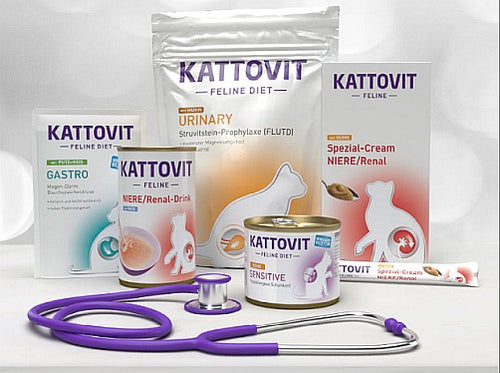Newsletter
Subscribe to Newsletter
Stay informed and always up to date with KATTOVIT. Be the first to hear about new products, discounts, advice texts, etc.
Schon ab 30€ ist deine Bestellung versandkostenfrei!
Mit deiner Anmeldung erklärst du dich mit unserer Datenschutzerklärung einverstanden.

Mit deiner Anmeldung erklärst du dich mit unserer Datenschutzerklärung einverstanden.
Cart
Your cart is empty
Our KATTOVIT weight-reducing treatment helps underweight and weakened cats gain weight. To do this, we use balanced ingredients and a high-calorie yet easily digestible recipe - based on the latest veterinary findings and more than 40 years of experience.
Filters
Filters
Top Bewertungen
Sehr gute Zusammensetzung...mein Kater hat fast alle Sorten gefressen. Im Großen und Ganzen, wunderbares Futter. Aber jede Katze ist anders

Ich füttere das Futter seit 4 Wochen. Meine Katze ist 18 Jahre alt und sieht manchmal etwas ausgemergelt aus. Durch das Aufbaufutter hat sie zugenommen und sieht wieder glatter aus. Sie kommt mit einer halben Dose pro Tag aus und frisst ansonsten ihr altes Futter. Sie ist leider eine sehr mäkelige Katze und kann nicht viele Futtersorten vertragen und übergibt sich dann schnell. Das ist mit dem Futter von Kattovit nicht passiert. Sie frisst es sehr gerne und verträgt es gut. Ich kann es gerne weiterempfehlen.

Meine Katze hat Nierenprobleme. Ich muss das Futter umstellen. Sie ist sehr wählerisch. Aber eure Produkte isst sie !!! Trocken und Nassfutter. Ich bin sehr zufrieden.

Die Aufbaukur Tüten. Sind super! Meine Katze isst die wirklich gut, hat endlich wieder mehr Appetit und bisschen zugenommen. Bin wirklich begeistert.

Your Questions - Our Answers
frequently asked Questions
There are many causes of weight loss in cats. Poor nutrition or food refusal due to an incorrect bowl can be responsible. However, parasites and various diseases can also cause loss of appetite and consequently weight loss. If your cat becomes steadily thinner, you should look out for other symptoms and consult a vet.
Cats have different ideal weights depending on their breed or sex. However, you can also tell whether a cat is too thin by its external appearance. If you look at the animal from above, sunken flanks are a sign of underweight. The same applies to a flat or even inwardly curved belly. Protruding hip bones and ribs also clearly indicate malnutrition. If the cat has thick and long fur, you can also carefully run your fingers along the ribs. You should only be able to feel them slightly. If you can feel them easily, the cat is probably too thin.
Proper nutrition is the most important thing for a malnourished cat. The animal is probably suffering from deficiency symptoms due to being underweight, which is why normal cat food is not sufficient to eliminate these. Special build-up diets with selected ingredients help the cat to regain its normal weight without having to eat large additional quantities. When refeeding, it is also important to ensure that the gastrointestinal tract is spared. It is therefore better to feed your cat several small portions at a lukewarm temperature than a few large portions straight from the fridge. If your cat is still hesitant about the food, you can also make it more interesting with a little tuna.
If cats have been operated on under anaesthetic, the body initially needs a few hours to re-sort itself. Coordination and the swallowing mechanism are still impaired immediately after the anaesthetic and the gastrointestinal tract also needs some time to function as before. You should therefore not offer your cat anything to eat in the first few hours after an operation anyway. Only provide water, but supervise your cat while it drinks. You can observe your cat to best judge when it will be able to eat again without any problems. When your cat's gait, behaviour, breathing and swallowing have returned to normal and the animal signals that it is hungry, you can start again with small, easily digestible portions. If the loss of appetite persists over a longer period of time or if the cat refuses to eat for other reasons, you should contact a vet.
How long an infected cat can live with the disease depends on many different factors. It is therefore not possible to give a clear answer to this question. This is not least due to the fact that FIV belongs to the so-called lentiviruses, which can lie dormant in the body unnoticed for a while before breaking out. If the affected cat's immune system is already weakened or it may be suffering from a previous illness, the course of the disease can end fatally more quickly than in an otherwise perfectly healthy cat. Advanced age can also accelerate the onset and progression of the various stages, as can the external influences that affect the cat and determine whether it comes into increased contact with other bacteria and viruses. Once the final stage of the feline Aids disease has been reached, the four-legged friends usually have no more than a year to live. During this phase, the disease progresses rapidly and can be very stressful for both the animal and its owner. Even if cat Aids cannot be cured, you can at least intervene to alleviate the symptoms after diagnosis. Always discuss this with the vet treating your cat.
The cat disease FIV is known as feline aids. It is a viral infection that is transmitted between cats via saliva and blood. In the body of the affected animal, feline Aids can initially go unnoticed for a while - but in the long term the disease attacks the carrier animal's white blood cells, weakening the immune system. The first signs are often fever, swollen lymph nodes and diarrhea - later on, feline Aids makes the affected animals particularly susceptible to secondary diseases. Whether gastrointestinal infections, inflammation of the teeth or cancer - the weakened immune system can no longer fight the pathogens, so infected cats have a greatly increased risk of falling ill again and again and even succumbing to the consequences in the end.
If you notice symptoms of FIP, i.e. the virus could not be successfully fought off by the immune system and breaks out, a fatal outcome was long considered inevitable. This realization is painful and very sad. For some time now, however, veterinarians and scientists have been conducting research at full speed. The reason for this is a promising drug for the treatment of FIP, which is still in the test phase. As it has not yet been approved for the German market, it is a case of waiting and hoping. Close communication with the vet is essential.
Feline asthma usually results from an allergy. When the cat comes into contact with the allergen, i.e. the intolerable substance, for the first time, the immune system immediately produces antibodies. These bind to certain immune cells - more precisely to the mast cells and the so-called basophilic granulocytes. Upon renewed contact with the allergen, the allergen and the antibodies reach the mast cells and granulocytes, which in turn release pro-inflammatory substances. So while the immune system actually pulls out all the stops to fight the allergen, it actually triggers an overreaction in the body. The body's own substances that cause the inflammation ultimately ensure that the bronchial tubes constrict considerably. This is caused by mucus deposits and cramps in the muscles and can be felt by the cat in the form of breathing difficulties.
FIP is a viral infection caused by infection with the feline coronavirus. This means that your cat cannot easily catch FIP from another cat - but it can catch FCO viruses. Whether these mutate in the cat's body depends on various factors that can hardly be influenced. Transmission of feline coronaviruses to humans is not possible, but humans can act as carriers - for example, if small particles of faeces get caught in clothing and are ingested by other cats.

Newsletter
Subscribe to Newsletter
Stay informed and always up to date with KATTOVIT. Be the first to hear about new products, discounts, advice texts, etc.
Proven Quality
Tested quality based on the latest veterinary findings
Always fresh
Guaranteed freshness, direct from the manufacturer - for the best care for your pet.
40 years of experience
More than 40 years of experience and expertise in the production of high-quality animal feed.